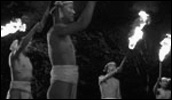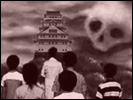The Ravaged House
- Year
- 2004
- Original title
- Tadareta Ie Zoroku no Kibyo
- Japanese title
- 爛れた家 蔵六の奇病
- Alternative title
- The Ravaged House: Zoroku's DIsease
- Director
- Cast
- Running time
- 63 minutes
- Published
- 22 December 2005


by Nicholas Rucka
Hideshi Hino is probably the most infamous but, until relatively recently, least known horror manga artist in the world. His pustule-popping, rainbow-colored, flesh nightmares have gummed up mangas for nearly 40 years, influencing many artists who dwell in the realm of horror and the fantastic including Junji Ito, Kanako Inuki, and Suehiro Maruo.
Hino's mangas are perhaps best described as Peanuts on a very bad acid trip. His drawings are disarmingly cute with his stories typically centered on very 'wrong' situations and outcomes. It is not unusual to have stories about lizard babies, pustule-covered artists who use the ichor from their weeping sores as paint, or a boy who devolves into a flesh-hungry worm-beast.
Given the twisted and bizarre content of his works, it's perhaps not surprising that Hino has been relegated to the dark alleys of Japan's manga culture. But with such visceral and prurient thrills to be found in his stories, it's strange that there have been so few film or direct-to-video adaptations of his works.
In 2004, Pony Canyon decided to rectify this situation by releasing six original short videos under the Hideshi Hino's "Theater of Horror" banner. Adapted from six different Hino manga stories, these shorts have been shot by different filmmakers using digital video, with wildly diverse approaches to the source materials. The Hiroshi Takahashi-scripted The Boy From Hell, for example, is a cherry lollypop colored piece that feels like a karaoke video ground up with Dario Argento's Deep Red - spirit gum and latex still visible. As the title states, The Boy From Hell, is about a boy from, well, hell. The boy was once a normal, happy child - the apple of his mother Setsu Emma's eye - who, due to some stupid circumstance, dies horribly. Ms. Emma is understandably devastated by her son's untimely death, so it's a good thing then (wouldn't you know it) that she is a top-notch surgeon! Which means, if given the opportunity she has the skills to fix up her son.
Fortunately, or unfortunately, for Ms. Emma, the opportunity comes in the form of a super creepy, white-haired witch who teaches Ms. Emma the secret of reanimation (with just a little bit of innocent boy blood sprinkled on the burial mound). Ms. Emma is positively irrational in her anguish and not only jumps at the opportunity to bring back her little boy, but also does the kidnapping, killing, and invocation herself! Amazingly, her son does come back to life-just with an insatiable hunger for bloody fresh human meat! Mmm... Flesh for the beast! Ms. Emma, it seems, has gone where angels fear to tread... And you can figure out the rest.
Truthfully, that's about the sum of The Boy From Hell. Due to its ineptitude and budget videomaking it provides some passing diversion if you like this sort of thing: uninspired cinematography, clunky performances, and community theater make-up effects. That said, the most significant point that arises out of The Boy From Hell is its accidental perfect illustration of how difficult a literal adaptation of a manga to live-action storytelling can be to pull off - especially if you're on a shoestring budget.
On the other hand, there's Kazuyoshi Kumakiri's interpretation of The Ravaged House. Kumakiri goes in a radically different direction that successfully turns a gruesome little story about art deriving from decay into a profound musing on the nature of prejudice and social ostracism. Even now I'm surprised that I'm writing this about a Hideshi Hino adaptation, but it's totally true.
Zoroku, the eldest son of a small family in rural Japan, is struck by an unknown ailment that swiftly mutates and decomposes his body. His family is at a loss for what to do and quickly bitter divisions arise between the father who is sickened by Zoroku, the mother who is confused by him, and the younger sister who desperately tries to protect the older brother she loves. Soon, members of the village become fearful that the rumors of a virulent disease outbreak at Zoroku's house is true and their behavior becomes positively inhuman towards Zoroku as they verify that something is seriously - and disgustingly - wrong with him.
Where shall I start? This is the first time I've seen 24p DV (shot on the Panasonic DVX-100a) that truly looks like super-16mm film. The cinematography is fantastic - there are long takes that are stunning in their execution with long lens shots that are dead-ringers for any film-shot stuff and dolly moves that are usually very difficult to execute on video without blurring, shaking, or banding. The performances are also top notch with subtle and nuanced choices that make Zoroku's (and his sister's) plight even more heart-wrenching to watch.
Kumakiri has masterfully metered out a story, which is not only philosophical but also insightful. There is no question that this surpasses the source manga material and somehow reaches a realm of higher storytelling that I was, quite frankly, pleasantly surprised to see. I'll make this plain: I was NOT expecting to see a film like this in Hideshi Hino's "Theater of Horror." Which makes it an additional gem.
At the risk of over-praising the film, I need to state that this is one of the better films that I have seen from the recent Japanese crop. Not only was it shot on video but additionally, at a lean 63 minutes, it is positively economical in its storytelling: less is truly more. I can only hope that this will be released abroad at some point soon for more people to enjoy. So listen up Pony Canyon: you can keep the silly Boy from Hell for all I care, Kumakiri's The Ravaged House needs to be released.